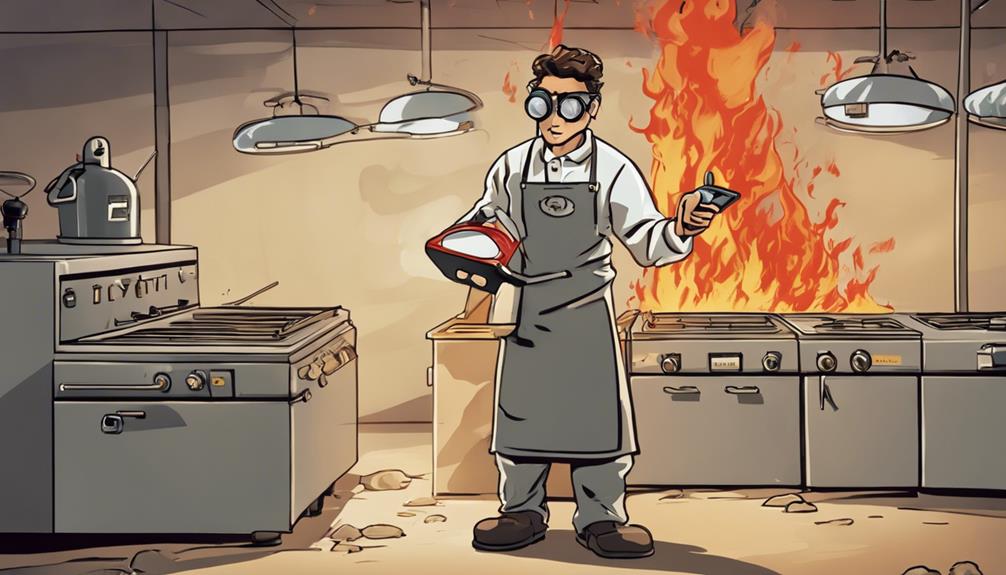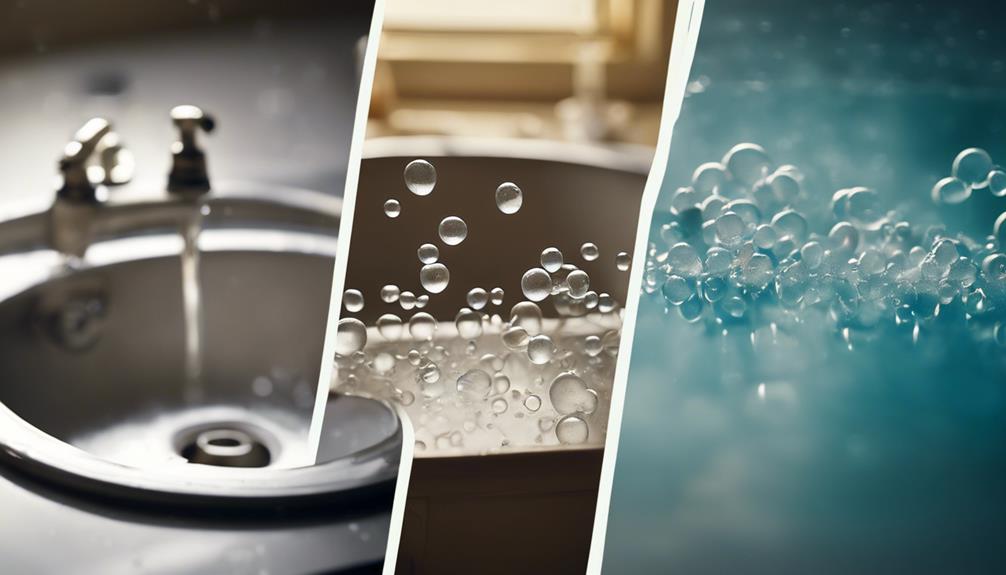You're curious about the science behind kitchen grease hacks, and it's not just about magic tricks! The secrets lie in understanding smoke points, effective absorption, and clever chemical reactions. You see, when you heat oil past its smoke point, it degrades and produces unwanted smoke. But using the right oil for the job, like avocado oil for high-heat cooking, makes a huge difference. Meanwhile, activated charcoal filters and natural absorbers like flour or starch help remove impurities. And, when you mix in some vinegar and baking soda, you get a potent cleaning cocktail. As you explore these hacks further, you'll discover even more clever ways to conquer kitchen grease.
Science Behind Smoke Points
Knowing the smoke point of oil is vital when heating it, as this is the critical temperature at which it starts to degrade and produce smoke. As you heat oil, you need to be mindful of this temperature to prevent it from breaking down and affecting the flavor and nutritional value of your dish.
Different oils have varying smoke points, and understanding these differences is key to choosing the right oil for your cooking method. If you're frying, you'll want an oil with a high smoke point to prevent it from burning and imparting a bitter taste to your food.
When you heat oil beyond its smoke point, you're not only damaging the oil's nutritional value but also creating harmful compounds. This can be disastrous for your health and the flavor of your dish.
Absorbing Impurities Effectively
As you tackle kitchen grease, you'll need to purify grease traps, filter out impurities, and absorb excess oil to get the job done.
By mastering these techniques, you'll be able to effectively absorb impurities and get your kitchen sparkling clean.
Purifying Grease Traps
Regularly purifying your grease trap is essential to guarantee it effectively absorbs impurities and continues to function properly. This ensures your kitchen operations run smoothly and you comply with environmental regulations. A clean grease trap prevents odors, backups, and plumbing issues, making it essential for commercial kitchens.
To maintain your grease trap, follow these steps:
- Scrape off excess grease: Remove large chunks of grease and food particles from the trap to prevent clogs.
- Use a degreaser: Apply a degreaser to break down stubborn grease and grime.
- Rinse thoroughly: Flush the trap with hot water to remove any remaining debris.
- Perform regular maintenance: Schedule regular cleanings to prevent buildup and maintain peak performance.
Filtering Out Impurities
You can greatly enhance the efficiency of your kitchen's grease management by implementing an effective filtration system that absorbs impurities from the oil. This is where filtering out impurities comes in – a vital step in maintaining the quality of your oil.
When you use an activated charcoal filter, it effectively absorbs impurities from the oil, removing particles, flavors, and odors that can affect the taste and quality of the oil. By doing so, you'll trap burnt food particles and other contaminants, ensuring the oil remains clean and free of impurities.
The filtering process is essential in maintaining the quality of the oil for reuse. By absorbing impurities, you'll prevent the buildup of contaminants that can affect the flavor and aroma of your dishes.
With an effective filtration system, you can rest assured that your oil is clean and free of impurities, making it perfect for reuse. By incorporating filtering into your kitchen's grease management, you'll be able to enjoy high-quality oil that's free from impurities, ensuring your dishes turn out delicious and flavorful.
Absorbing Excess Oil
To tackle excess oil and grime, try sprinkling flour or starch on the affected surfaces, and watch as they absorb impurities like a magnet, lifting grease and dirt with ease. As you apply the flour or starch, you'll notice how effectively they absorb excess oil and impurities, making it easy to wipe away the grime.
Here's how it works:
- Flour and starch absorb excess oil: Their absorbent properties help lift grease and grime from surfaces, making it easy to remove built-up oil and dirt.
- Natural cleaning agents: Flour or starch acts as a natural cleaning agent by trapping oil and residue, making it easy to wipe away the grime.
- Combination of oil absorption and cleaning action: The combination of oil absorption and cleaning action makes this hack effective for removing grease and grime.
- Easy cleaning: With the flour or starch absorbing excess oil and impurities, you're left with a clean surface that's easy to wipe down.
Safety Precautions for Fryers

As you start exploring the world of fryer hacks, it's important to prioritize safety by following some important precautions.
You'll want to guarantee your fryer is in top condition, so it's time to learn some fryer maintenance tips to prevent accidents and make cooking a breeze.
Fryer Maintenance Tips
Proper fryer maintenance is essential to preventing accidents and fires, and it starts with avoiding overheating oil. You can't stress enough the importance of keeping your fryer in top condition to guarantee your safety while cooking.
Here are some essential tips to keep in mind for proper fryer maintenance:
- Check your oil temperature: Before using your fryer, make sure the oil has reached a safe temperature for cooking and cleaning. Overheating oil can lead to accidents and fires.
- Choose the right cleaning hack: When it comes to soaking up grease, using the appropriate type of flour or starch is vital. The type and amount you use will depend on the size of your fryer.
- Adjust for fryer size: Don't assume a one-size-fits-all approach when it comes to cleaning hacks. Be mindful of the size of your fryer and adjust your cleaning hack accordingly.
- Consider compatibility: Not all cleaning hacks are created equal, and some may be more effective than others depending on the type of fryer you have. Make sure to choose a cleaning hack that's compatible with your fryer for best results.
Proper Fryer Cleaning
You'll need to take certain precautions when cleaning your fryer to avoid injuries and messes. As you tackle the task of removing grease and food residue from your kitchen's most-used appliance, it's important to prioritize safety.
One key step is to make sure the oil has cooled down to a safe temperature before starting the cleaning process. This will prevent splattering and burns.
When using a flour or starch-based hack to absorb excess grease, make sure to use the correct type and adjust the measurements according to your fryer's size. This will ensure excellent results and prevent any ineffective cleaning attempts.
It's also crucial to think about the applicability of the cleaning hack to different types of fryers, as what works for one might not work for another.
Oil Types and Food Pairing
When it comes to cooking, selecting the right oil for the job can make all the difference in bringing out the flavors and textures of your dishes. You might be wondering why you're struggling to get rid of those pesky grease stains, but it might be because you're using the wrong oil for the task.
Here are some oil types and their ideal food pairings:
- Olive oil: Perfect for low to medium heat cooking, pair it with Mediterranean-inspired dishes or use it as a finishing oil for soups and salads.
- Avocado oil: With its high smoke point, it's ideal for high-heat cooking methods like frying and sautéing. Try pairing it with bold flavors like garlic and ginger.
- Coconut oil: Add a unique flavor profile to your baked goods, curries, and sautéed vegetables.
- Canola oil: A neutral option for frying due to its high smoke point and mild taste. It's perfect for delicate foods like fish and vegetables.
Community Refinements and Tips

Many of you have likely experimented with different kitchen grease hacks, so now it's time to share your experiences and feedback on what works and what doesn't. We want to hear about your successes and failures, and what you've learned along the way.
Have you found a particular hack to be a game-changer in your kitchen, or do you have a hack that you swear by? Share your story and help refine these hacks for the benefit of the entire community.
We're also looking for your input on specific details. For instance, what type of flour works best for absorbing excess grease, or what's the best oil temperature for top-notch results? Your insights will help us adapt these hacks for different types of fryers, such as turkey fryers.
Join the conversation by leaving a comment, sharing your feedback, and using relevant hashtags to reach a wider audience. Together, let's refine these hacks and make them even more effective.
What's your favorite kitchen grease hack, and how has it changed the way you cook?
Chemical Reactions in Cleaning
As you explore the world of kitchen grease hacks, it's fascinating to uncover the scientific secrets behind the cleaning processes, particularly the chemical reactions that make natural ingredients so effective at breaking down and removing grease.
When you mix and match natural ingredients, you're creating chemical reactions that work wonders on tough grease stains. Here's how it works:
- Acidic Breakdown: Vinegar's acetic acid breaks down grease molecules, making them easier to remove.
- Emulsification: The combination of oil and vinegar creates an emulsion that lifts and removes grease effectively.
- Alkaline Neutralization: Baking soda's alkaline nature helps neutralize acids in grease, aiding in its removal.
- Effective Cleaning: Chemical reactions between natural ingredients and grease molecules result in effective cleaning.
These chemical reactions are the key to successful kitchen grease hacks. By understanding how natural ingredients interact with grease, you can create powerful cleaning solutions that make quick work of even the toughest stains.
Surfactant Properties Explained

You're likely familiar with the magic of surfactants in your favorite kitchen grease hacks, but do you know how they actually work to make cleaning so much easier? It's because surfactants have unique properties that allow them to reduce surface tension. This enables water and oil to mix, making it possible to break down and lift grease molecules from surfaces.
When you add surfactants to homemade cleaners like vinegar and oil, you enhance their cleaning power. The interaction between surfactants and grease is what leads to effective removal. In essence, surfactants act as emulsifiers, allowing water and oil to mix, which is vital for cleaning grease.
Practical Applications and Results
One effective way to put surfactant properties into action is by combining d-limonene from orange peels with white vinegar to create a powerful grease-fighting spray. This homemade spray is a game-changer when it comes to tackling tough grease and grime in your kitchen. You'll be amazed at how easily it cuts through thick dust and grease on your cabinets, leaving them looking like new. Plus, it's a safer alternative to chemical cleaners, containing no harsh chemicals and having a mild scent.
Here are some impressive results you can expect from this hack:
- Effective grease removal: The spray showed great results on greasy surfaces like the microwave and stovetop.
- Cabinet-friendly: A spot test confirmed the spray didn't leave any stains on white cabinets.
- Tough on grease, gentle on surfaces: The combination of d-limonene and vinegar is a potent grease-fighting duo that's gentle on surfaces.
- Easy to make and use: This DIY spray is a simple and effective cleaning tip to add to your arsenal of kitchen cleaning hacks.
Conclusion
Now that you've mastered these kitchen grease hacks, your cooking game is on fire! Like a well-oiled machine, you're effortlessly whipping up crispy fries and succulent meats.
As you continue to refine your skills, remember that science is on your side. With an understanding of smoke points, absorption, and surfactants, you're unstoppable.
So, keep experimenting, sharing, and perfecting your craft – your taste buds (and friends) will thank you!